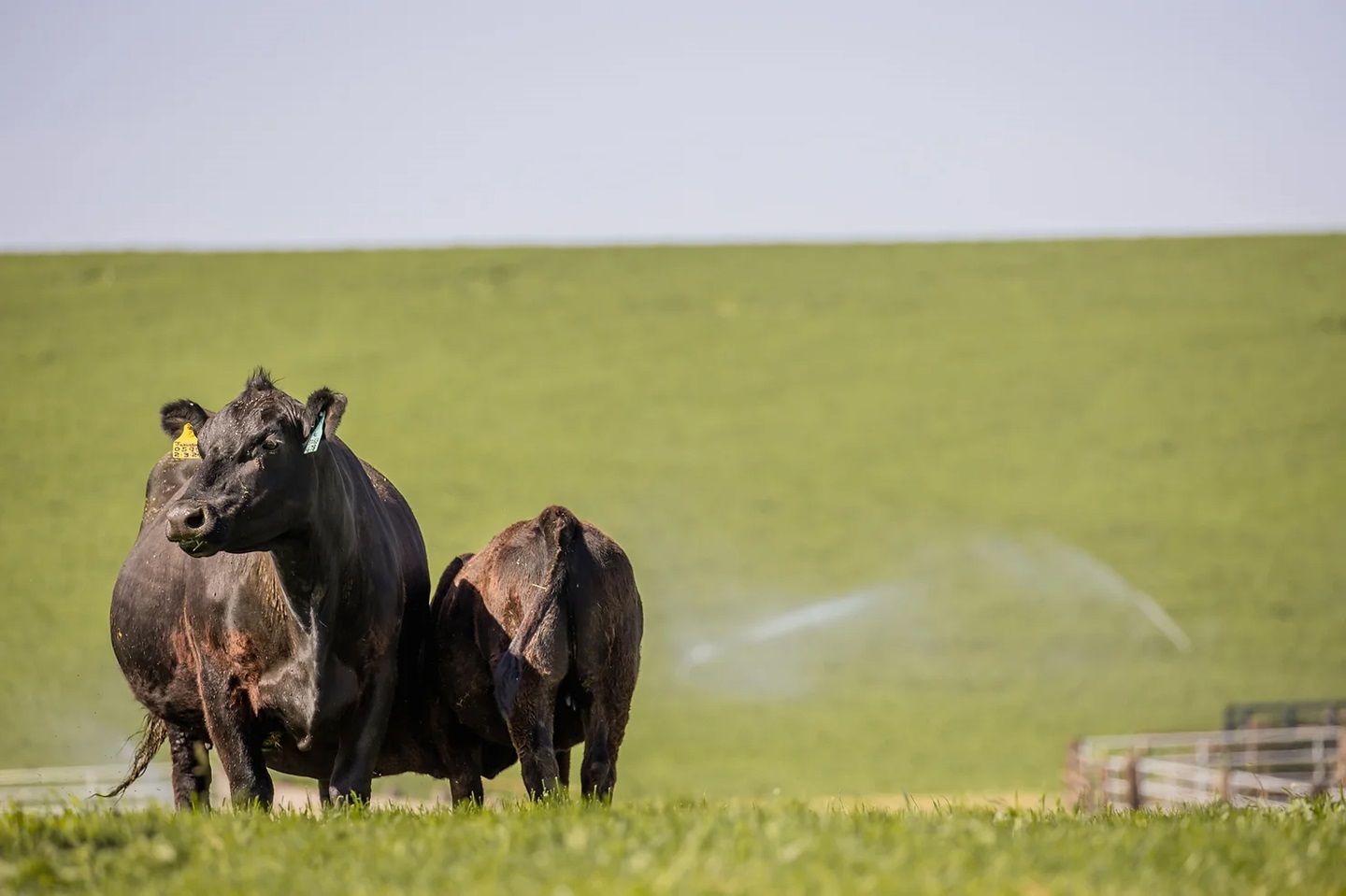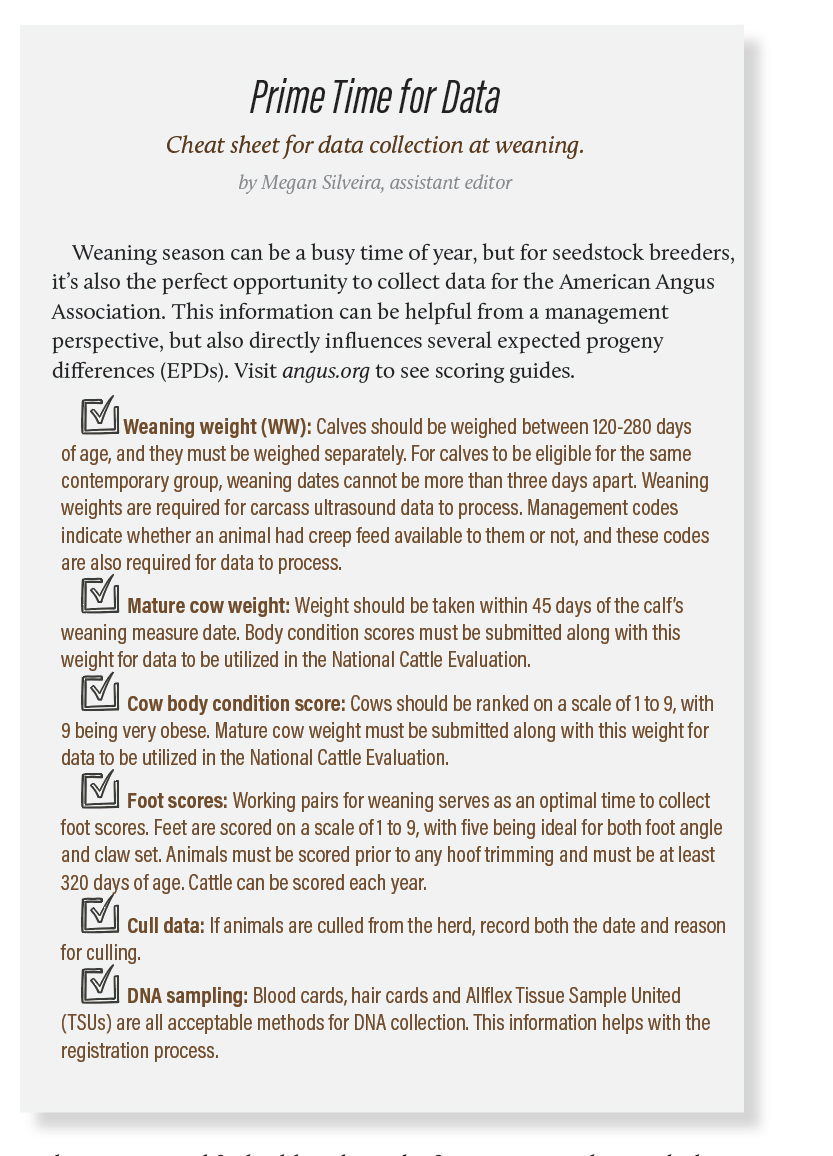Weaning on the Ranch: Considerations for a Better Outcome
Strategies and tips for weaning calves.
August 1, 2023
“Calves that don’t eat get sick, and sick calves don’t eat.”
Sarah McKenzie says her dad has cited that cow country axiom often, emphasizing the role calf appetite plays in the weaning process. A calf’s interest in eating is a good indicator of how well it is adjusting to what likely is the most stressful stage in the life of a bovine beast.
“Calves are more willing to eat if they’re comfortable, so we work hard at minimizing stress and making calves as comfortable as we can,” McKenzie says.
McKenzie Land and Livestock includes registered and commercial Angus operations near Fort Stockton, Texas, and Santa Rosa, N.M. On both ranches, preparation for calf comfort starts early.
Certainly, weaning is a time when cattle are likely to experience physical and emotional stress. It’s a time of transition — nutritionally, socially and environmentally. Even when weaning calves on the ranch of origin, change of diet, separation from the cow and exposure to different physical surroundings contribute to stress.
Collectively, these stressors can negatively affect immune response; but they also may cause reduced feed and water intake. That creates even more stress and further depresses immune function.
Weaning management can influence subsequent calf health and performance, as well as long-term economic viability. However, there is no one-size-fits-all weaning strategy. Every cow-calf producer must choose a method that works for his or her operation. Three common weaning strategies include abrupt separation, fenceline weaning and two-stage weaning, any of which can be adapted to fit an operation’s particular circumstances.
Weaning in effect
McKenzie says abrupt separation is applied at both of her family’s ranching locations. Weaning typically occurs in early May, but weather and forage availability can shift the schedule either way. Working with consulting veterinarians, a vaccination protocol targets immunization against viral respiratory diseases, clostridial infections and pinkeye. Additionally, injectable mineral supplement is administered at weaning.
“Here in Texas, we give shots on the day we wean and a second round two weeks later. In New Mexico, the first shots are given two weeks preweaning and a second round on weaning day,” McKenzie says. “Because they’re born in the fall, our calves are with their mothers in the winter and get accustomed to being fed. They know what feed is, and it’s usually pretty easy to get them to eat once they’re in the pens.”
The weaning pens are large, offering easy access to feed and water, plus shade from the sun. Commingling of calves from different pasture groups is avoided, as McKenzie says calves get over separation anxiety quicker without the socialization issues that result from mixing animals from different herds. She emphasizes calves stay in the weaning pens no longer than necessary. Often, they’re out and on pasture within a couple of weeks.
While considerable effort is invested in facilities and procedures that make the weaning event as comfortable as possible, McKenzie says it’s important cattle are prepared for the experience. A good health program is part of that, but every interaction between humans and the cattle also contribute. The cattle are worked often enough, using low-stress stockmanship, such that calves are acclimated to handling.
“We try to do everything we can to mitigate stress during weaning,” McKenzie explains, “but it starts long before that, with quiet and effective handling.”

Gerald Stokka agrees preparation should start early. The North Dakota State University Extension veterinarian believes successful weaning management begins at birth, by making sure every calf receives sufficient colostrum.
“The right start is critical to health and performance,” Stokka says, advising producers to work with a veterinarian to implement a vaccination program that’s appropriate for their particular operation and local health challenges.
He emphasizes adherence to vaccine manufacturer directions. That means using two doses at the proper interval, whenever product directions call for two doses.
Acclimation to gentle, effective handling should start early, too. According to Stokka, producers who use synchronized artificial insemination (AI) have ample opportunity, since calves must be separated from cows during each step of a synchronization protocol and for insemination. Every time cattle are handled, it’s a learning experience — for better or worse.
Stokka adds a caveat, however, reminding producers to avoid such separations for prolonged periods or during the heat of the day. Resulting stress can contribute to summer pneumonia among calves.
“To get calves to eat and keep eating during weaning, familiarity with the feed is a big advantage,” Stokka adds. “That’s the beauty of feeding cows and calves together before weaning. Nursing calves learn to eat what their mothers eat. What that is may vary by operation and time of year. Whether it’s hay, silage, cake (protein/energy cubes) or some kind of mixed ration, weaned calves will keep eating feed that’s familiar.”
According to Stokka, when pairs have been grazing pasture and calves have had little or no exposure to other feedstuffs, creep-feeding for a short period prior to weaning might be worth consideration.
“I’m not a big fan of creep-feeding to add weaning weight, but I do like using creep to introduce calves to feed,” Stokka explains. “I also discourage commingling calves from different pastures on weaning day. The social or psychological stress it creates is a pretty big deal that’s added to the stress of separation from mama. A way around it might be to bring different groups of pairs together a couple of weeks before weaning. That gets all resocialization out of the way first.”
Stokka says all of these considerations are applicable to every weaning method. The abrupt separation method remains most common, but fenceline weaning is gaining traction. This method consists of separating cows and calves into different adjacent pens, paddocks or pastures with a shared fence. Held on opposite sides of this fence, cows and calves can have nose-to-nose contact, but calves cannot nurse. Allowing calves to remain in a familiar environment while adapting to separation has been shown to reduce stress, with less fence-walking and decreased bawling among calves.
“Fenceline weaning decreases stress, but it takes a good fence — a really good fence,” Stokka says.
Two-stage weaning is an alternative reduced-stress method. The first stage involves placing anti-nursing devices in each calf’s nose and allowing the calves to remain with their dams for a few days prior to actual separation. These “nose flaps” allow calves to graze, eat feed and drink water; but prevent nursing during the period cows and calves remain together. The second stage involves removing the nose flaps and separating calves from cows permanently.
“The two-stage method is considered less stressful, because it divides weaning into two separate and relatively low-stress events,” Stokka says. “You don’t have to leave the nose flaps in for very long. Usually, seven days is long enough. After 10 days, they can cause irritation that may lead to infection.”
Fenceline weaning is favored by growing numbers of Darr Feedlot customers, according to co-owner Craig Uden, who handles procurement for the 48,000-head feedyard located near Cozad, Neb. He’s been on the receiving end of calves that have undergone weaning experiences both good and bad.
“Fenceline weaning seems to work well for cow-calf producers that can get set up for it, especially if they can wean calves on grass. That might be ideal,” Uden says, noting the advantages of a familiar environment and diet. “What doesn’t work so well is weaning at the hottest time of the year in crowded, dusty pens.”
Uden recommends weaning at home when possible, with preconditioning vaccinations given while calves are still on grass with their dams. When moving calves to weaning pens, allow plenty of space and use bedding to control dust. Hydration is critical for health and to keep cattle eating, so calves need easy access to an ample water supply. Uden says allowing water to overflow temporarily can help coax calves to drink, especially when they aren’t accustomed to waterers.
“Before shipping to a feedyard, calves should be weaned at least 45 days, but 60 days is better. Don’t commingle until calves are weaned at least 45 days. Sorting steers from heifers at weaning also avoids the stress of sorting at delivery,” Uden suggests. “And be picky about the truckers you hire. Experience has value.”
Lastly, Uden reminds producers that stockmanship matters.
“From birth to harvest, everything we do to handle cattle better and reduce stress will help us reach a better outcome,” he says.

Topics: Animal Handling , Management , Health
Publication: Angus Journal


